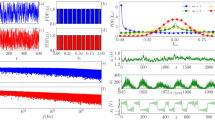Abstract
Previous studies suggesting that people predict chaotic sequences better than chance have not discriminated between sensitivity to nonlinear determinism and facilitation using autocorrelation. Since prediction accuracy declines with increases in the look-ahead window in both cases, a decline in prediction accuracy does not imply chaos sensitivity. To overcome this problem, phase-randomized surrogate time series are used as a control. Such series have the same linear properties as the original chaotic sequence but contain no nonlinear determinism, i.e. chaos. In the experimental task, using a chaotic Hénon attractor, participants viewed the previous eight days temperatures and then predicted temperatures for the next four days, over 120 trials. The control group experienced a sample from a corresponding phase-randomized surrogate series. Both time series were linearly transformed to provide a realistic temperature range. A transformation of the correlation between observed and predicted values decreased over days for the chaotic time series, but remained constant and high for the surrogate series. The interaction between the days and series factors was statistically significant, suggesting that people are sensitive to chaos, even when the autocorrelation functions and power spectra of the control and experimental series are identical. Implications for the psychological assessment of individual differences in human prediction are discussed.
Similar content being viewed by others
REFERENCES
Casdagli, M. (1992). Chaos and deterministic versus stochastic non-linear modelling. Journal of the Royal Statistical Society Series B, 54, 303–328.
Ferriere, R., Cazelles, B., Cezilly, F., & Desportes, J.-P. (1996). Predictability and chaos in bird vigilant behaviour. Animal Behaviour, 52, 457–471.
Heath, R. A. (2000). Nonlinear dynamics: Techniques and applications in psychology. Mahwah, NJ: Erlbaum.
Heath, R. A., Kelly, A., & Longstaff, M. (2000). Detecting nonlinearity in psychological data: Techniques and Applications. Behavior Research Methods, Instrumentation & Computers, 32, 280–289.
Hegger, R., Kantz, H., & Schreiber, T. (1999). Practical implementation of nonlinear time series methods: The TISEAN package. Chaos, 9, 413–435.
Herbert, B. (1999). Decision making and chaotic sensitivity in humans. Unpublished Honours thesis, Department of Psychology, University of Newcastle, Australia.
Kaplan, D., & Glass, L. (1995). Understanding nonlinear dynamics. New York: Springer-Verlag.
Khadra, L. M., Maayah, T. J., & Dickhaus, H. (1997). Detecting chaos in HRV signals in human cardiac transplant recipients. Computers and Biomedical Research, 30, 188–199.
Mandelbrot, B. B. (1999). Multifractals and 1/f noise. New York: Springer-Verlag.
Metcalf, L. (2000). Chaos prediction ability and intelligence: An initial examination. Unpublished Masters degree thesis. School of Behavioural Sciences, University of Newcastle, Australia.
Metzger, M. A. (1994). Have subjects been shown to generate chaotic numbers? Commentary on Neuringer and Voss. Psychological Science, 5, 111–114.
Metzger, M. A. (1995). Multiprocess models applied to cognitive and behavioral dynamics. In Port, R.F., & van Gelder, T. (Eds.), Mind as motion: Explorations in the dynamics of cognition. (pp. 491–526) Cambridge, MA: The MIT Press.
Metzger, M. A., & Theisz, M. F. (1994). Forecast: Program to obtain forecasts from subjects for successive values of chaotic time series. Behavior Research Methods, Instruments, & Computers, 26, 387–394.
Neuringer, A., & Voss, C. (1993). Approximating chaotic behavior. Psychological Science, 4, 113–119.
Plous, S. (1993). The psychology of judgment and decision making. Philadelphia: Temple University Press.
Ruxton, G. D., & Roberts, G. (1999). Are vigilance sequences a consequence of intrinsic chaos or external changes? Animal Behaviour, 57, 493–495.
Smithson, M. (1997). Judgment under chaos. Organizational Behavior and Human Decision Processes, 69, 59–66.
Tabachnick, B. G., & Fidell, L. S. (1996). Using multivariate statistics (3rd Ed.). New York: HarperCollins.
Ward, L. M, & West, R. L. (1998). Modeling human chaotic behavior: Nonlinear forecasting analysis of logistic iteration. Nonlinear Dynamics, Psychology, and Life Sciences, 2, 261–282.
Author information
Authors and Affiliations
Rights and permissions
About this article
Cite this article
Heath, R.A. Can People Predict Chaotic Sequences?. Nonlinear Dynamics Psychol Life Sci 6, 37–54 (2002). https://doi.org/10.1023/A:1012206002844
Issue Date:
DOI: https://doi.org/10.1023/A:1012206002844




